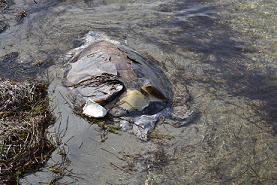Using AI to control energy for indoor agriculture
30 September 2024
Published online 9 March 2014

A high death rate was reported in October 2012, after up to a hundred sea turtle carcasses were found on the shores of Lake Bardawil in North Sinai, a site listed among the Ramsar Wetlands of International Importance.
The mission, carried out by representatives from Nature Conservation Egypt (NCE), the Mediterranean Association to Save the Sea Turtles (MEDASSET) and Suez University, Egypt, took samples, interviewed fishermen and have now reported their findings.
During initial surveys experts realized the deaths were not from a single incident as some of the carcasses had been decomposing for months. "Nonetheless, 16 of these died in just one month, which is a cause of concern," says Kostis Grimanis, the director of MEDASSET.
"Some carcasses were so decomposed that we could not tell the gender or which family of sea turtles they belonged to," says MEDASSET's representative in Egypt, Mohamed Nada.
Of all five sea turtle species found in the world's oceans, three frequent the Egyptian Mediterranean shores for foraging and wintering grounds. The most commonly-found turtle on this coast is the Loggerhead (Caretta caretta), followed by the Green (Chelonia mydas) and the Leatherback (Dermochelys coriacea), the latter being just an occasional visitor.
Of the 96 dead sea turtles found, only 74 could be clearly identified through photographic evidence. "Most of the dead turtles were Loggerheads, one was a Green turtle and another a Leatherback," explains Noor Noor, the executive director of NCE who took part in the lake field survey.
"Four turtles had been decapitated, and one died from a head trauma caused by a blunt object" explains Nada.
We saw with our own eyes a fisherman bringing a sea turtle ashore and beheading it.
Due to budgetary constraints, the team, on foot, could only explore 20% of the lake's shores during their two-day visit and were unable to screen the bottom of the lake.
In the absence of necropsies and toxicological tests, researchers could not definitively conclude why the turtles were dying in Bardawil, but assert that fishermen were primarily responsible for the deaths. The sea creatures, which have been present in the highly-saline lake for less than five years, compete for fish with fishermen and often collide with fishing boats and tear up costly nets. "We saw with our own eyes a fisherman bringing a sea turtle ashore and beheading it," says Noor.
Lake Bardawil has become an attractive wintering ground for sea turtles, says Nada. Newer fishing practices, like bottom trawling, have reduced the sea bass population of the lake, because fine mesh nets trap both adult and juvenile fishes. "By law, fishermen are forbidden to use nets with meshes smaller than 40mm. In Bardawil, they fish with 8mm nets," explains Nada.
The declining sea bass population, combined with an increased water salinity has attracted shrimps and crabs – the sea turtles' favoured food.
In order to gather fish and crustaceans in certain areas of the lake, some fishermen dump tires and other large objects into the water to create a sort of shelter for them. But the turtles also go to the shelters to feed on these creatures, generating anger among fishermen. "Some fishermen told us that others poison small fish to ultimately kill the turtle that will feed on it, although no one we interviewed would admit to such practices," says Nada.
The report also highlights buoyancy failure after collisions with boats result in the turtle's inability to sink in the water. Lake Bardawil can also be highly saline, and combined with extremely high water temperatures in the summer it could have created unbearable conditions for the turtles.
The lake is one of the less polluted bodies of water in the country, so the experts agree that pollution seems improbable as a major source of mortality, "although we don't totally discard debris ingestion," says Nada.
"The high sea turtle mortality and the fisheries conflict are an indicator that there is lots of room for improvement in the field of conservation and management of this Ramsar site", says Magdy El-Alwany, from the Marine Biology Department of the Suez Canal University.
Nada calls for the creation of a national committee to review the problems encountered by the Bardawil fishermen, and recommends for the lake to be declared a marine protected area. "Of course we need to think in a sustainable way and involve the fishermen in this process, which means helping them develop a second source of income other than fishing," he concluded.
doi:10.1038/nmiddleeast.2014.58
Stay connected: